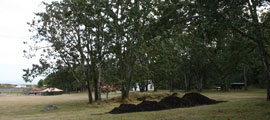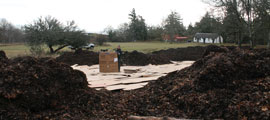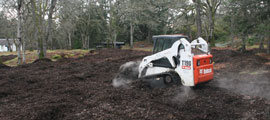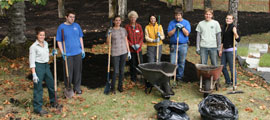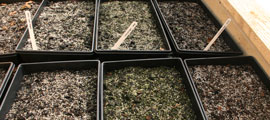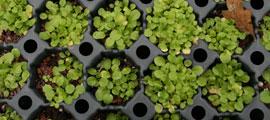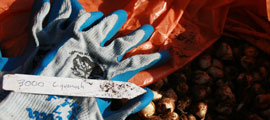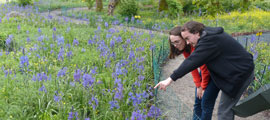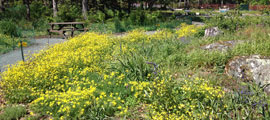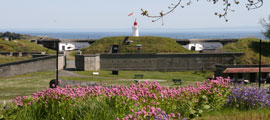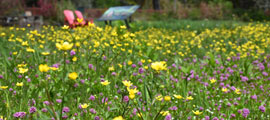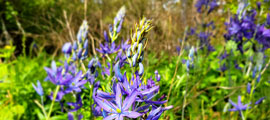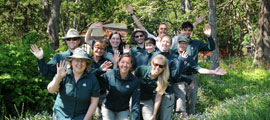Ecosystem Restoration
Fort Rodd Hill and Fisgard Lighthouse National Historic Sites
The Garry Oak Learning Meadow
Transcript
Parks Canada logo.
Garry Oak Learning Meadow.
Fort Rodd Hill and Fisgard Lighthouse National Historic Sites.
[Shots of the Garry Oak Learning Meadow's plants and trees.]
Garry oak ecosystems are a really special ecosystem, and we like to call them an eco-cultural landscape.
‘Eco’ meaning ecological, and ‘cultural’ because of their longstanding significance to the Coast Salish First Nations.
The Coast Salish First Nations coexisted with Garry oak ecosystems for thousands of years.
We can think of them really as Coast Salish gardens.
It’s a very unique ecosystem in Canada. There’s literally over 900 species of plants, so it’s a very biodiverse ecosystem.
"Aimée Pelletier. Species at Risk Communications Officer. Parks Canada.
"[Aimée Pelletier is standing in the Garry Oak Learning Meadow, surrounded by flowering plants.]
Unfortunately, here on Southern Vancouver Island there’s only 5% remaining of the original range of Garry oak ecosystems.
And that has a lot to do with forestry practices, with conversion of meadow lands to agriculture,
with the fact that it’s a very lovely place to live, so people like to build their houses here,
and also because there’s a lot of invasive species.
[Wide shot of the Garry Oak Learning Meadow in bloom.]
So what we wanted to do here was create one acre of Garry oak habitat.
[Photographs of buttercup, blue camas and pink seablush.]
What you see here is a typical mix for a Garry oak ecosystem.
We’ve got lots of - this yellow stuff here is all buttercup, blue camas, you can see some pink seablush back there.
Those are sort of the dominant, iconic species of the Garry oak meadows,
and then there’s probably about 50 other species that we have in here too.
"Cheryl Bryce. Songhees Nation.
"[Cheryl Bryce is standing in a field in the Garry Oak Learning Meadow.]
Everything has a very strong connection, but they also have a use. So, there’s so many things:
There’s food resources here, there’s tool making resources here, it’s a home for many things as well.
[Close-up photographs of various plant species in the Garry oak ecosystem.]
They’re all important as far as making sure the whole system thrives. I refer to it as a food system.
So, everything needs each other to fully thrive. And it needs us too. We’re a part of that food system.
[Narrative returns to Aimée Pelletier.]
When I started with this project, this acre here that you see, which is full of wildflowers now, was just a lawn.
"Nathan Fisk. Resource Management Officer. Parks Canada.
"[Nathan Fisk is standing in front of an interperetive panel in the Garry Oak Learning Meadow.]
The first few years were just about building up the soil. Mostly everything inside the meadow was planted,
starting with the big shrubs and then moving on to the grasses and the flowering plants.
[Sequence of images showing the initial stages of the learning meadow's development: Mulch is laid down on the lawn, volunteers spread the mulch, the first plants and shrubs are planted.]
The work that’s going on now, we’re sort of evolving away beyond the common species
and towards more of the rare species, a lot of the species that were identified in the recovery strategies.
[Images of plants growning in the gardening nursery.]
"Susan MacIsaac. Species at Risk Communications Officer. Parks Canada.
"[Susan MacIsaac is standing in a field in the Garry Oak Learning Meadow.]
Volunteers have always been a huge part of the success of this program. They've helped do everything
from plant the actual plants into the ground, to mulching everything, making sure the ground was prepared.
[Footage of volunteers digging through mulch and planting small plants.]
It’s amazing to see what can be done in an area that was just lawn. So, this whole area used to be just grass,
[Images of plants and animals in the Garry Oak Learning Meadow: A robin, a racoon, a bee, a hummingbird, a hawk and a butterfly.]
and now it’s this diverse ecosystem that’s attracting so many other species to it.
They’re all coming into this meadow because there’s so much food, so much shelter, so much diversity here.
So it’s really neat to see nature coming back.
[Narrative returns to Cheryl Bryce.]
[Panoramic shots of the Garry Oak Learning Meadow.]
Coming in here, you see the urgent need of having to make sure this is here for future generations.
And development is the hugest impact, of course, to a lot of the old ecosystems.
There’s very few places you can find them, and they’re very fragmented when you find them.
So having these in place shows people they can do this in their backyard.
It’s knowledge that’s important to pass on to create awareness and to show that it’s really in an urgent state,
that we need to be protecting but also reinstating a lot of these very, very important food systems.
[Images of visitors exploring the Garry Oak Learning Meadow.]
So if you want to come and learn about nature or conservation in action,
Parks Canada’s Garry Oak Learning Meadow at Fort Rodd Hill has something for everyone, and it’s definitely worth a visit.
Visit ParksCanada.ca/FortRoddHill to plan a visit or volunteer for the Garry Oak Learning Meadow.
Parks Canada logo.
© Her Majesty the Queen in Right of Canada, represented by Parks Canada, 2017.
Canada wordmark.
Under the guidance of lək̓ʷəŋən knowledge and with help from hundreds of volunteers, a one-acre area of lawn in the heart of Fort Rodd Hill and Fisgard Lighthouse National Historic Sites has been transformed into a thriving Garry Oak meadow and woodland demonstration site.
The meadow features a huge variety of native trees, shrubs and wildflowers that are naturally adapted to the region’s wet winters and long summer drought. The Garry Oak Learning Meadow is not a manicured garden; it is designed and maintained as a sustainable and evolving living landscape.
Endangered coastal oakscapes
The Garry Oak ecosystem was once a vast savannah of towering Garry Oak trees and wildflower meadows that sustained Coast Salish peoples for millennia. Garry Oak ecosystems have been reduced to less than 5% of their former extent in Canada.
Garry Oak ecosystems face many pressures. Before the practice was banned by early colonizers, First Nations burned Garry Oak meadows seasonally to keep the meadows open and to encourage the growth of staple food plants like Camas. A century of fire suppression has enabled native tree and shrub species like Douglas-fir and Snowberry to invade meadows, eventually transforming them into closed woodlands. When this happens, Garry Oak trees, and their associated carpets of wildflowers, are lost.
Heavy development pressure on southern Vancouver Island and the Gulf Islands has swallowed up much of the original habitat and left the remaining Garry Oak ecosystems highly fragmented. These remaining “islands” of habitat are much more vulnerable to introduced invasive species like Scotch Broom, Himalayan Blackberry, English Ivy, English Holly and Spurge-laurel. These invasive species take over and make growing conditions unsuitable for many native plants.
You can’t walk far at Fort Rodd Hill without spotting a deer. In the absence of natural predators like cougars and wolves, native Columbia Black-tailed Deer have become hyperabundant throughout the region. Overgrazing by deer removes understory forest vegetation, which has been linked to declines in songbird populations in the region.
A special meadow

Since 2011, Parks Canada has been collaborating with First Nations, volunteers and other collaborators to protect and restore Garry Oak ecosystems, known as Camas meadows by Coast Salish First Nations.
Fort Rodd Hill National Historic Site was chosen for the location of the Garry Oak Learning Meadow because it is home to some of the rarest ecosystems in Canada.
How the meadow came about
A one-hectare site was selected within Fort Rodd Hill main field. Garry Oak ecosystems ecological processes were mimicked through the removal of invasive species and a select few trees, to imitate the effects of an eco-cultural burn.
How it started – with a lot of dirt and helping hands!
Ready to plant – from the nursery to the meadow, the seeds grew.
The first results – an oasis of blooming flowers for visitors to see.
Today - The Garry Oak Learning Meadow is a vibrant place to visit throughout the seasons.
Where we grow
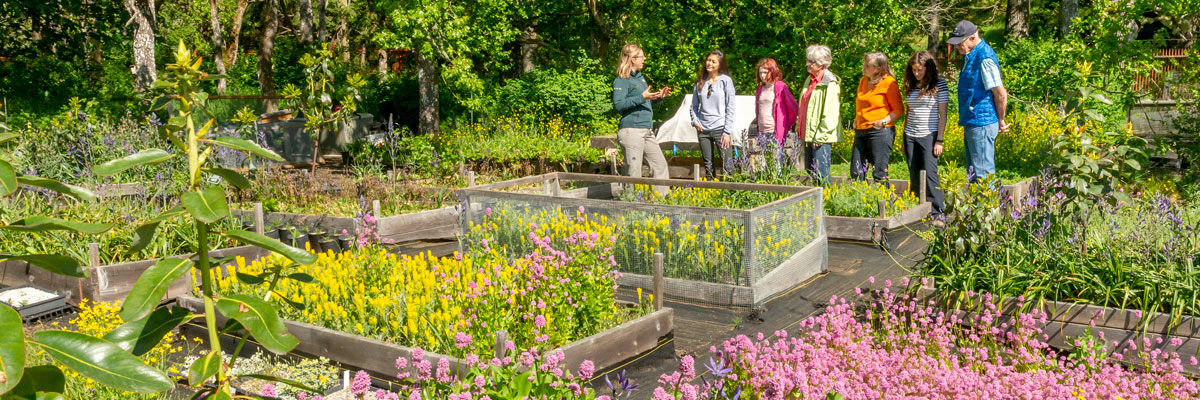
Garry Oak and associated ecosystems are found within the Fort Rodd Hill National Historic Site and the Gulf Islands National Park Reserve, both managed by Parks Canada. The protection and recovery of at-risk species in these ecosystems are guided by collaboratively-developed recovery strategies and action plans (including Parks Canada multi-species action plans required under the Species at Risk Act). Special funding fuels conservation projects, focusing on ecosystem restoration and monitoring. Educating and fostering awareness about at-risk species and their habitats remains an important part of our work.
Over 10,000 native plants were grown from seed in an on-site Conservation Nursery and then planted within the fenced area of the Garry Oak Learning Meadow. Predominantly sourced from seeds hand-collected within the historical sites, the nursery has evolved into a highly productive hub. The Conservation Nursery now also supplies seedlings and plants for restoration activities in Gulf Islands National Park Reserve.
Another purpose of the Garry Oak Learning Meadow and Conservation Nursery at Fort Rodd Hill is to increase the availability of culturally important species. Parks Canada takes direction from First Nations on which species of interest Nations would like to have more readily available and welcomes First Nations partners to harvest these species to support cultural and ceremonial practices in-community (e.g., Camas pit cooks, provision of medicines to community Elders). Parks Canada also grows a variety of other native species to support Indigenous-led restoration projects on First Nations lands and has been directly involved in planting these species during community restoration days.
Sharing knowledge
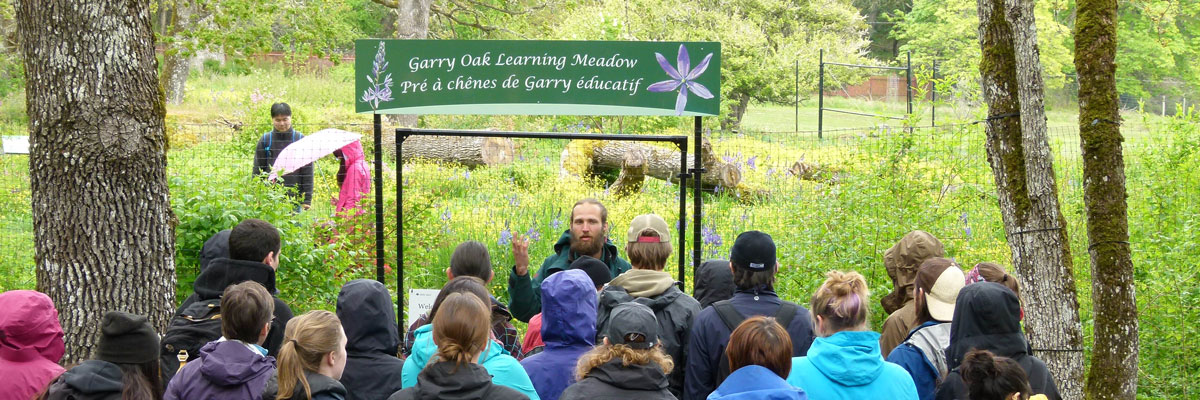
In the summer, interpreters rove the Learning Meadow and share interesting facts about its inhabitants.
The Garry Oak Learning Meadow also offers a self-guided interpretive trail, passing by educational panels and plant signs. An inviting resting area with two Parks Canada Red Chairs and a picnic table provides a stunning view of the meadow and Lower Battery.
In the Learning Meadow, visitors can observe and learn about the various plant species that make up this ecosystem, including wildflowers, grasses, and other native vegetation. They can also learn about the importance of pollinators, such as bees and butterflies, in supporting these plants and maintaining the health of the ecosystem.
In addition to its educational value, the Garry Oak Learning Meadow also serves as an important habitat for many species of birds, insects, and other wildlife. By exploring and appreciating this unique ecosystem, visitors can gain a deeper understanding of the importance of preserving and protecting natural habitats and biodiversity.
NOTE: The Learning Meadow can be accessed via two entry gates. The first one is immediately on the left after entering the historical sites. Our recommendation is to use the second gate, located under a Coast Salish carved arch about 150 metres from the Welcome Centre. This second entrance will give you a better appreciation of the Coast Salish art. The 100-metres path between the entrance of the site and the start of the learning meadow trail has a maximum 2% slope (mostly flat) and is packed gravel. You will find a resting area with the two Red Chairs on a slightly uneven stone pavement. This path is maintained year-round. If you encounter an obstacle, such as fallen tree branches, please report it to one of our staff members at fortrodd@pc.gc.ca.
Did you know?
Garry Oak ecosystems are referred to as Kwetlal (Camas) food systems in some of the local Coast Salish cultures. They are home to many medicinal plants and traditional foods. Harvested Camas bulbs, Chocolate Lily and other root vegetables were slowly cooked in pit cooks—a traditional method of food preparation used by Coast Salish people.
Some say Camas bulbs taste like chestnuts!
Related links
- Date modified :
